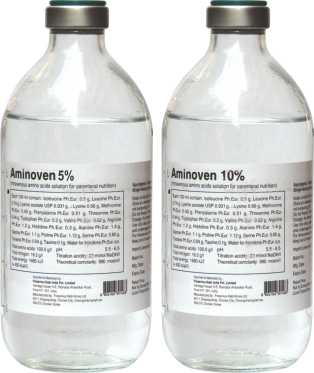- Contains a balanced pattern of non-essential and conditionally essential amino acids
- The only standard amino acid solution containing taurine which is conditionally essential
- Meets the requirements for essential and branched chain amino acids
- Provides high biological value of 136 based on "Potato-egg principle”
- Contains different concentrations with different osmolarity to allow both peripheral and central administration
Aminoven 5%, 10%
- Features
- Indication
- Dosage
- Benefits
- References
- Productinfo
- For supply of amino acids as part of a parenteral nutrition regimen. Amino acid solutions should be administered generally in combination with adequate amount of energy supplements.
- Aminoven 5%, 500 ml glass bottle , 16-20 ml/kg body wt (equivalent to 0.8-1.0 g AA/kg body wt)
- Aminoven 10% , 500 ml glass bottle, 10-20 ml/kg body wt (equivalent to 1.0-2.0 g AA/kg body wt.)
- Amino acid composition based upon established solutions with proved nutritional efficacy and excellent tolerance and supports better protein synthesis
- Taurine is conditionally essential amino acid in critical illness, trauma , sepsis, cancer, radiation and chemotherapy
- Taurine also has immune-modulatory effects and may alleviate cholestasis in post-operative patients
1. Stapleton PP, Chrles RP, Redmond HP, Bouchier-Hayes DJ: Taurine and human nutrition. Clin Nutr 16 (1997) 103-108
2. Desai Tk, et al, Taurine deficiency after intensive chemotherapy and/or radiation. Am J Clin Nuti 1992;55:708-711
3. Paauw JD, Davis AT. Taurine concentations in srum of critically injured patients and age and sex-matched healthy control subjects. Am Clin Nutr 1990;52:657-660
4. Chiarla C et al, The relationship between aurine and other amino acid levels in human sepsis J Nutr 2000;130:2222-2227
5. Geggel HS, Amend ME, Heckenlively JR, Martin DE, Kopple JD: Nutritional requirement for taurine in patients receiving long-term parenteral nutrition. N Engl J Med 312 (1985) 142-146
6. Kopple JD, Vinton NE,Laidlaw SA, Ament ME: Effect of intravenous taurine supplementation on plasma, blood cell, and urine taurine concentrations in adults undergoing long-term parenteral nutrition. Am J Clin Nutr 52 (1990) 846-853
7. Wang WY, Liaw KY. Effect of taurine supplemented diet on conugated bile acids in biliary surgical patients JPEN 1991;15:294-297
8. Redmont HP et al. Immunonutrition: The role of taurine. Nutr 1998;14:599-604
9. Cooper A et al. Taurine deficiency in the severe hepatic dysfunction complicating total parenteral nutrition J Ped Surg 1984;19:462-466
Characteristics AA EAA NEAA BCAA Total Nitrogen (g /L/pack) Total Kcals Osmolarity (mosmol/L) Infusion Rate Max.Dosage (ml/kg/day) Shelf life (months) Route of Adm | Aminoven 5% 25g 41% 59% 18.60% 4.05 100K 495 34 drops/min 20 24 peripheral | Aminoven 10% 50g 41% 59% 18.60% 8.1 200K 990 17 drops/min 20 24 peripheral/central |
